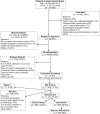Intervention attendance among emergency department patients with alcohol- and drug-use disorders
- PMID: 20731976
- PMCID: PMC2930501
- DOI: 10.15288/jsad.2010.71.713
Intervention attendance among emergency department patients with alcohol- and drug-use disorders
Abstract
Objective: The emergency department (ED) visit provides a window of opportunity for screening and linkage to services for inner-city adults with substance-use disorders (SUDs). This article examines predictors of intervention attendance among ED patients who screen positive for an SUD (alcohol or other drug).
Method: As part of a large randomized control trial, medical and injured patients (ages 19-60) in an inner-city ED completed a computerized screening survey. Based on random assignment, those screening positive for an SUD either were scheduled to attend a post-discharge intervention or received a referral brochure. Interventions (brief motivational intervention vs. case management intervention) focused on linking participants to substance-use treatment. Independent variables assessed included demographics, ED visit reason, health functioning, readiness to change, self-efficacy, and substance use. Intervention attendance (yes/no) was the dependent variable.
Results: Overall, 957 (62.3% male; 58.3% African-American; M(age) = 33.2 years) were randomized to interventions (brief motivational intervention/case management intervention) and are the focus of subsequent analyses. There were no differences in the pattern of predictors of intervention attendance for brief motivational intervention versus case management intervention. Bivariate analyses compared those who attended the post-ED intervention with those who did not attend. Participants who attended the intervention (50%) were significantly more likely to be older, unmarried, insured, unemployed, and in the "action" stage of change.
Conclusions: The present findings highlight the relative importance of assessing and attending to readiness to change as well as demographic factors such as insurance and employment (and potentially associated barriers) in ED-based screening, brief intervention, and referral to treatment protocols.
Figures

References
-
- Andersen RM. Revisiting the behavioral model and access to medical care: Does it matter? Journal of Health and Social Behavior. 1995;36:1–10. - PubMed
-
- Annis HM, Graham JM, editors. Situational Confidence Questionnaire User's Guide. Toronto, Canada: Addiction Research, Centre for Addiction and Mental Health; 1988.
-
- Babor TF, McRee BG, Kassebaum PA, Grimaldi PL, Ahmed K, Bray J. Screening, brief intervention, and referral to treatment (SBIRT): Toward a public health approach to the management of substance abuse. Substance Abuse. 2007;28:7–30. - PubMed
-
- Baird J, Longabaugh R, Lee CS, Nirenberg TD, Woolard R, Mello, MJ, Gogineni A. Treatment completion in a brief motivational intervention in the emergency department: The effect of multiple interventions and therapists' behavior. Alcoholism: Clinical and Experimental Research. 2007;31(10 Suppl):71s–75s. - PMC - PubMed
Publication types
MeSH terms
Grants and funding
LinkOut - more resources
Full Text Sources
Medical
Research Materials

